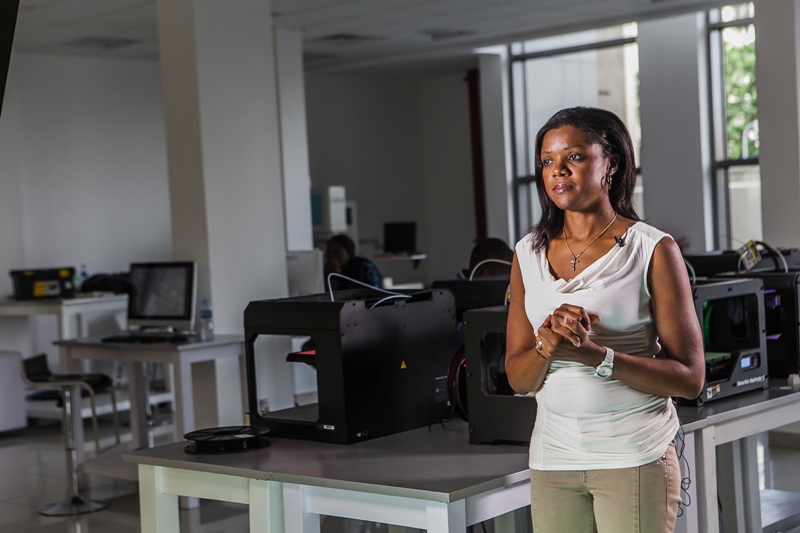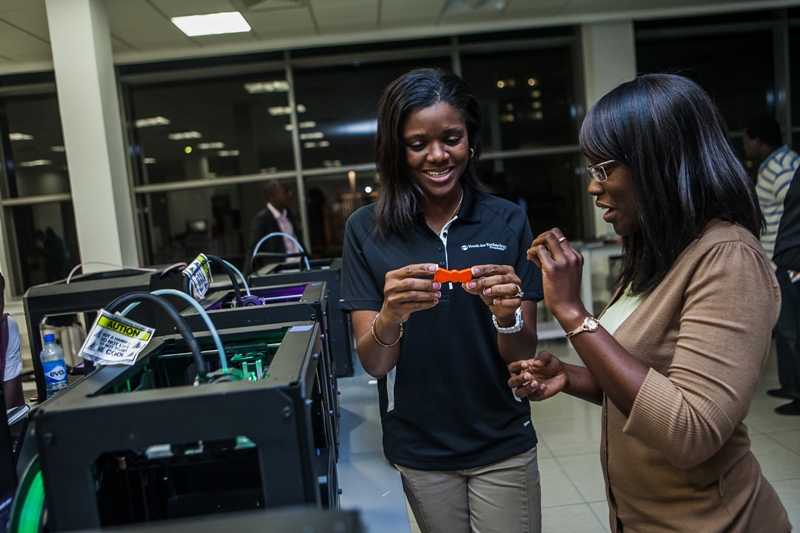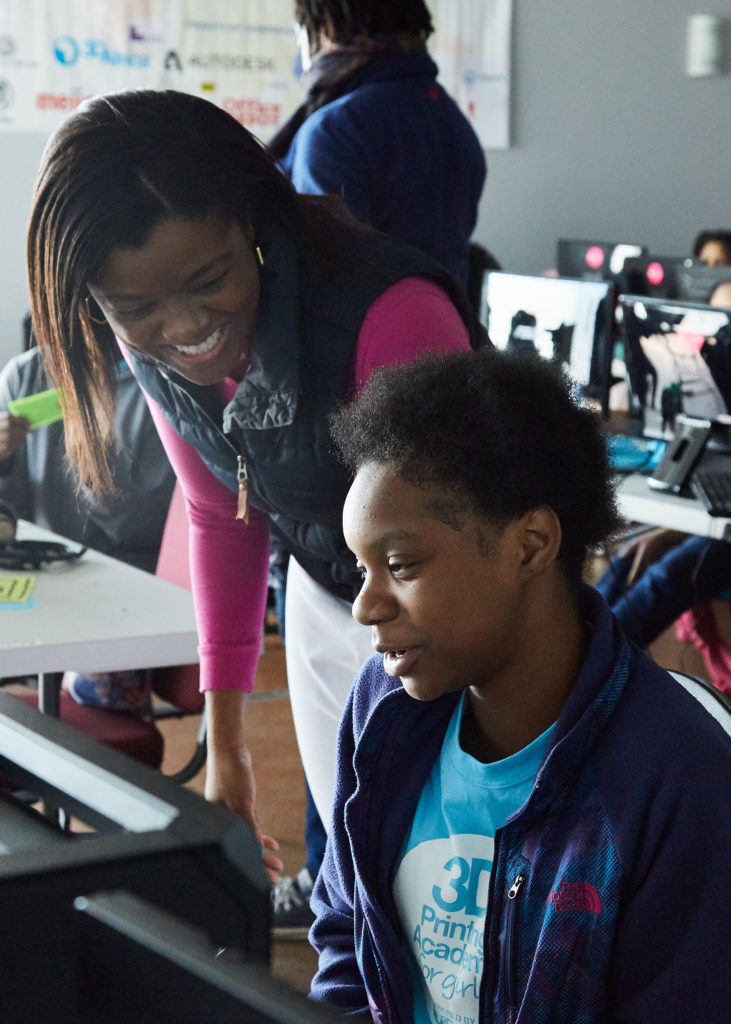Njideka Harry leads the organization, Youth for Technology Foundation (YTF) as President and CEO. YTF is an international non-profit founded in 2000 and working at the intersection of appropriate technology in education and entrepreneurship. YTF co-creates programs that leverage technology to upskill people so that they are better prepared in the classroom, for the world of work and that they have the tools and knowledge to start or expand their businesses. Our clients are youth and women.
In 2016, she founded 3D Printing Academy for Girls an education technology social impact company designed to leverage 3D printing and other emerging technologies to inspire Science, Technology, Engineering and Math careers in middle-school age girls. She is our guest in this #OpinionoftheWeek and will tell us more about her activities related to 3D printing.
What was your first experience with 3D printing? And why the attachment to this technology?
My first experience with 3D printing was probably about 4 years ago in 2014 when YTF launched 3D Africa, an education platform that exploits the power of emerging technologies, like 3D printing, to spark innovation and create entrepreneurship opportunities for youth and women. I remember first discussing the opportunity in the 3D printing market with someone from a private sector company in Nigeria and he in essence told me that while my idea was noble, he didn’t see it working in Nigeria as many wouldn’t be able to grasp the opportunity. He was wrong. Youth for Technology Foundation was the first social enterprise to expand into the 3D printing market in Nigeria and since then a few other companies have come into the market. We distinguish ourselves, though by not simply providing 3D printing services, but actually delivering training.
At YTF, we believe that emerging technologies, like 3D printing, allow people to design, invent and create the world they envision for themselves. In the maker movement, 3D printing is a key technology that allows innovation to be democratised; it’s a technology that opens doors and extends interest for people that often haven not been brought into the wings of Science, Technology, Engineering & Math (STEM) –primarily are girls and women.
As a mother of three daughters myself, I have witnessed how technologies like 3D printing help spark creativity and an interest in STEM related education, hence my founding of 3D Printing Academy for Girls.
Tell us more about YTF … What is the message behind this foundation?
The fundamental message behind YTF is really around the recognition that talent is universal but opportunity is not. And using technology as inspiration, our goal is to create opportunities and unlock potential in primarily young people and women who otherwise would never have an opportunity.
In today’s digital economy we know that access to technology is critical to advance in the areas of education, entrepreneurship whether one chooses to work for an employer or create jobs themselves. When we look broadly at how we accomplish our mission and what keeps us going, it is our ability to teach young people how to learn. We understand that if young people know how to learn, they can really change the world. We are on the brink of the fourth industrial revolution and though the future of work is uncertain, one thing is not and that is the shift. 65% of the children in primary school today will have jobs that don’t exist currently. There is a tremendous opportunity to make sure we are upskilling young people for the jobs they will eventually be in.
Tell us about two challenging projects you carried out with girls.
In many of the countries in Africa we work in, social and cultural stereotypes are still very deeply ingrained. We often find ourselves in situations where, in Nigeria or Kenya for instance, we have to convince the parents of a girl to attend our programs that are primarily afterschool. Typically, girls have after-school responsibilities caring for their younger ones or aging parents and having to divert that resource/time somewhere else, is a big challenge. The way we have been able to overcome some of those challenges is by including their parents, guardians, community members in the conversation from the onset. So that they know exactly how their daughters are going to be involved, the impact of this learning and technology and their daughter’s future. Very quickly they see the changes, the growth in their daughter, at home they see the leadership amongst their siblings and other classroom peers – they see that the programs are very effective and they continue to support their daughter in attending. I think overall more broadly of those societal challenges are still inexistence but we’ve been able to overcome them mostly due to the changes the parents see in their daughters.
In 2015, with support from Women Enhancing Technology (WeTech), YTF created 3D Africa Clubs in secondary schools around Nigeria, specifically focused on teaching 3D printing to girls. The program, called 3D Africa for Girls taught them how to use human centered design and computer aided design software, like Tinkercad and Fusion360, to design, invent and create products that will be beneficial to their communities. I remember, one of the students, Treasure designed and 3D printed wedding invitations for her brother’s upcoming wedding. Another student, Maureen, worked with one of the women entrepreneurs enrolled in another YTF program, to design combs, headbands and beads for her business. Probably the most inspiring outcome of the program to date for me was a group of secondary school girls in the program who modeled and designed a pendant as a gift for a donor’s fiancée. Soon after they were married, so a wonderful happy ending.

In 2016, we announced a commitment to provide 6,000 girls in Nigeria with digital literacy and 3D printing skills as part of our Clinton Global Initiative Commitment: 3D Printing Freedom from Human Trafficking for Girls. These girls are at-risk of human trafficking and this in itself is a challenging demographic but we can see true results when a girl decides to return to school to obtain an education instead of falling into prey of these victimizers because she doesn’t feel like she has other choice. This program is opening up opportunities for these girls.
Why the emphasis on “girls”?
Women and girls hold up half the universe and control as much as 80% of consumer spending. Despite this fact, women continue to be left behind in STEM education and careers. Women in STEM jobs earn at least 30% more than their female peers in non-stem jobs. Between 2010-2018, STEM occupations grew about 17% compared to non-STEM occupations. In this fourth industrial revolution, there is a likelihood that girls and women may be left even further behind if they do not understand how these disruptive and emerging technologies change the course of business. Many girls and women still hold jobs in lower rankings, like customer service jobs which are at higher risk of being automated. It is imperative that we upscale these girls and women so that they are able to transition into these jobs in the fourth industrial revolution; jobs that will require highly workers.

What advice do you give to young girls to encourage them to be a part of the 3D printing technology world?
It all boils down to sharing information about what opportunities are available in the 3D printing space all the while having the girl keep her own identity. 3D printing inspires girls to create and envision a world they want for themselves. We believe it’s important to start with outcomes, having identified what their concrete realities are, and then help them find cool projects that are meaningful to them.
Is there any other 3D printing project in the box?
We are always thinking ahead of ways to bring these disruptive technologies, like 3D printing, to people in the most impactful yet relevant ways. For my team and I, we know that the future belongs to the creators and the people whose ideas will shape and change the world for good.
For further information about 3D Printing, follow us on our social networks and subscribe to our newsletter
Would you like to be featured in the next issue of our digital magazine? Send us an email at contact@3dadept.com
//pagead2.googlesyndication.com/pagead/js/adsbygoogle.js
(adsbygoogle = window.adsbygoogle || []).push({});





